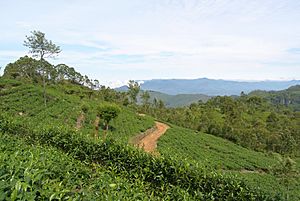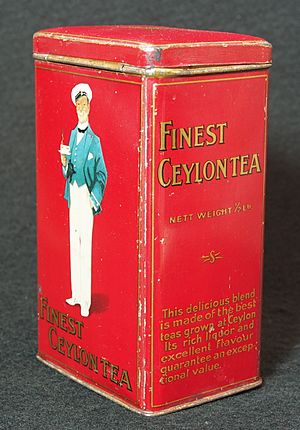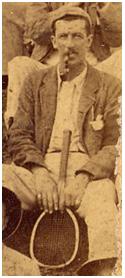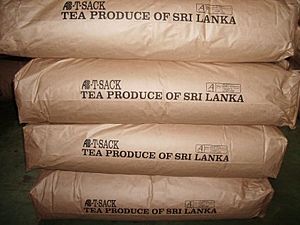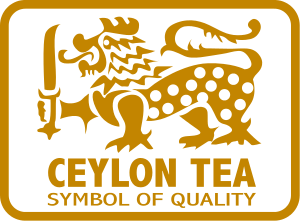Tea production in Sri Lanka facts for kids
Sri Lanka, once known as Ceylon, is a beautiful island country. It's famous for growing tea because it has the perfect weather and different elevations (how high up a place is). Most of the tea grown here is the Camellia sinensis var. assamica type.
Tea is super important for Sri Lanka's economy. It brings in a lot of money from other countries. In 2021, it made over $1.3 billion! Tea farming also provides jobs for more than 1 million people. Many families depend on growing tea on small farms.
Sri Lanka is the fourth-largest tea producer in the world. In 1995, it was the top country for exporting tea, sending out 23% of all tea sold globally. The country produced the most tea in 2013, with 340 million kilograms.
The cool, wet weather in Sri Lanka's central mountains helps grow high-quality tea. Tea from lower areas, like Matara and Galle, has a stronger taste. This tea is very popular in the Middle East. Sri Lanka mainly makes black teas, but also white and green teas.
The tea industry started in Sri Lanka in 1867. A British planter named James Taylor brought it to the island. Growing tea on smaller family farms became popular in the 1970s. Sri Lankan tea is sold all over the world, especially in the Middle East and Europe.
Contents
History of Tea in Sri Lanka
Tea farming began in Sri Lanka (then called Ceylon) a long time ago. Before tea, coffee was the main crop. But a disease wiped out most of the coffee plants in the 1860s.
This is when James Taylor stepped in. He had arrived in Sri Lanka in 1852. In 1867, he started the first tea plantation on a large farm called Loolecondera Estate. He showed everyone how to grow and process tea.
How Tea Farming Grew
Over the years, more and more land was used for tea. This table shows how much land was used for tea farms at different heights:
| Year | High areas (hectares) |
Medium areas (hectares) |
Low areas (hectares) |
Total (hectares) |
Total (square miles) |
|---|---|---|---|---|---|
| 1959 | 74,581 | 66,711 | 46,101 | 187,393 | 723.5 |
| 1960 | 79,586 | 69,482 | 48,113 | 197,181 | 761.3 |
| 1961 | 76,557 | 97,521 | 63,644 | 237,722 | 917.8 |
| 1962 | 76,707 | 97,857 | 64,661 | 239,225 | 923.7 |
| 1963 | 76,157 | 95,691 | 65,862 | 237,710 | 917.8 |
| 1964 | 81,538 | 92,281 | 65,759 | 239,578 | 925.0 |
| 1965 | 87,345 | 92,806 | 60,365 | 240,516 | 928.6 |
| 1966 | 87,514 | 93,305 | 60,563 | 241,382 | 932.0 |
| 1967 | 87,520 | 93,872 | 60,945 | 242,337 | 935.7 |
| 1968 | 81,144 | 99,359 | 61,292 | 241,795 | 933.6 |
| 1969 | 81,092 | 98,675 | 61,616 | 241,383 | 932.0 |
| 1970 | 77,549 | 98,624 | 65,625 | 241,798 | 933.6 |
| 1971 | 77,936 | 98,624 | 65,625 | 242,185 | 935.1 |
| 1972 | 77,639 | 98,252 | 65,968 | 241,859 | 933.8 |
| 1973 | 77,793 | 98,165 | 66,343 | 242,301 | 935.5 |
| 1974 | 77,693 | 97,875 | 66,622 | 242,190 | 935.1 |
| 1975 | 79,337 | 98,446 | 64,099 | 241,882 | 933.9 |
| 1976 | 79,877 | 94,338 | 66,363 | 240,578 | 928.9 |
| 1977 | 79,653 | 94,835 | 67,523 | 242,011 | 934.4 |
| 1978 | 79,628 | 95,591 | 68,023 | 243,242 | 939.2 |
| 1979 | 78,614 | 97,084 | 68,401 | 244,099 | 942.5 |
| 1980 | 78,786 | 96,950 | 68,969 | 244,705 | 944.8 |
| 1981 | 78,621 | 96,853 | 69,444 | 244,918 | 945.6 |
| 1982 | 77,769 | 96,644 | 67,728 | 242,141 | 934.9 |
| 1983 | 71,959 | 90,272 | 67,834 | 230,065 | 888.3 |
| 1984 | 74,157 | 90,203 | 63,514 | 227,874 | 879.8 |
| 1985 | 74,706 | 89,175 | 67,769 | 231,650 | 894.4 |
| 1986 | 73,206 | 85,216 | 64,483 | 222,905 | 860.6 |
| 1987 | 72,773 | 84,445 | 64,280 | 221,498 | 855.2 |
| 1988 | 72,901 | 84,227 | 64,555 | 221,683 | 855.9 |
| 1989 | 73,110 | 84,062 | 64,938 | 222,110 | 857.6 |
| 1990 | 73,138 | 83,223 | 65,397 | 221,758 | 856.2 |
| 1991 | 73,331 | 82,467 | 65,893 | 221,691 | 856.0 |
| 1992 | 74,141 | 85,510 | 62,185 | 221,836 | 856.5 |
| 1994 | 51,443 | 56,155 | 79,711 | 187,309 | 723.2 |
| 1995 | 51,443 | 56,155 | 79,711 | 187,309 | 723.2 |
| 1996 | 52,272 | 56,863 | 79,836 | 188,971 | 729.6 |
| 1997 | 51,444 | 58,155 | 79,711 | 189,310 | 730.9 |
| 1998 | 51,444 | 58,155 | 79,711 | 189,310 | 730.9 |
| 2000 | 52,272 | 56,863 | 79,836 | 188,971 | 729.6 |
Where Sri Lankan Tea Goes
Sri Lankan tea is sent to many countries around the world. The biggest buyers are countries that used to be part of the Soviet Union (like Russia), the United Arab Emirates, Syria, and Turkey.
Here's a look at the main countries that bought Sri Lankan tea in 2000:
| Country | Million kilograms |
Million pounds |
Percent of total |
|---|---|---|---|
| CIS Countries | 57.6 | 127.0 | 20 |
| UAE | 48.1 | 106.0 | 16.7 |
| Russia | 46.1 | 101.6 | 16.01 |
| Syria | 21.5 | 47.4 | 7.47 |
| Turkey | 20.3 | 44.8 | 7.05 |
| Iran | 12.5 | 27.6 | 4.34 |
| Saudi Arabia | 11.4 | 25.1 | 3.96 |
| Iraq | 11.1 | 24.5 | 3.85 |
| UK | 10.2 | 22.5 | 3.54 |
| Egypt | 10.1 | 22.3 | 3.51 |
| Libya | 10.0 | 22.0 | 3.47 |
| Japan | 8.3 | 18.3 | 2.88 |
| Germany | 5.0 | 11.0 | 1.74 |
| Others | 23.7 | 52.2 | 8.23 |
| Total | 288 | 634.9 | 100 |
Money from Tea Exports
The tea industry brings in a lot of money for Sri Lanka. Here's how much money was made from tea exports in recent years:
| Year | Total Money from Tea Exports (in million US$) |
|---|---|
| 2019 | |
| 2020 | |
| 2021 |
Tea Branding and Quality
The "Ceylon tea" brand is very important. The Sri Lanka Tea Board owns the special lion logo you see on tea packs. This logo means the tea is high quality.
For a tea pack to use the Lion logo, it must follow four rules:
- It must be a consumer pack of Ceylon tea (meaning it's ready for people to buy and drink).
- The pack must contain 100% pure Ceylon tea.
- The tea must be packaged in Sri Lanka.
- The tea brand must meet the quality standards set by the Sri Lanka Tea Board.
This logo is known worldwide as a sign of excellent tea. The Sri Lanka Tea Board even sponsors the Sri Lanka national cricket teams when they play in other countries!
Tea Research and Development
The Tea Research Institute
The Tea Research Institute (TRI) was started in 1925. It's the only national group in Sri Lanka that creates new ideas and technology for growing and processing tea. They help tea farmers and factories improve their methods.
Making Tea Sustainable
Many groups work to make sure tea farming in Sri Lanka is sustainable. This means they try to protect the environment and treat workers fairly.
Some of these groups are international, like Rainforest Alliance, Fairtrade, UTZ Certified, and Ethical Tea Partnership. There's also a local group called the Small Organic Farmers’ Association (SOFA) that supports organic farming.
Images for kids
See also
 In Spanish: Producción de té en Sri Lanka para niños
In Spanish: Producción de té en Sri Lanka para niños


